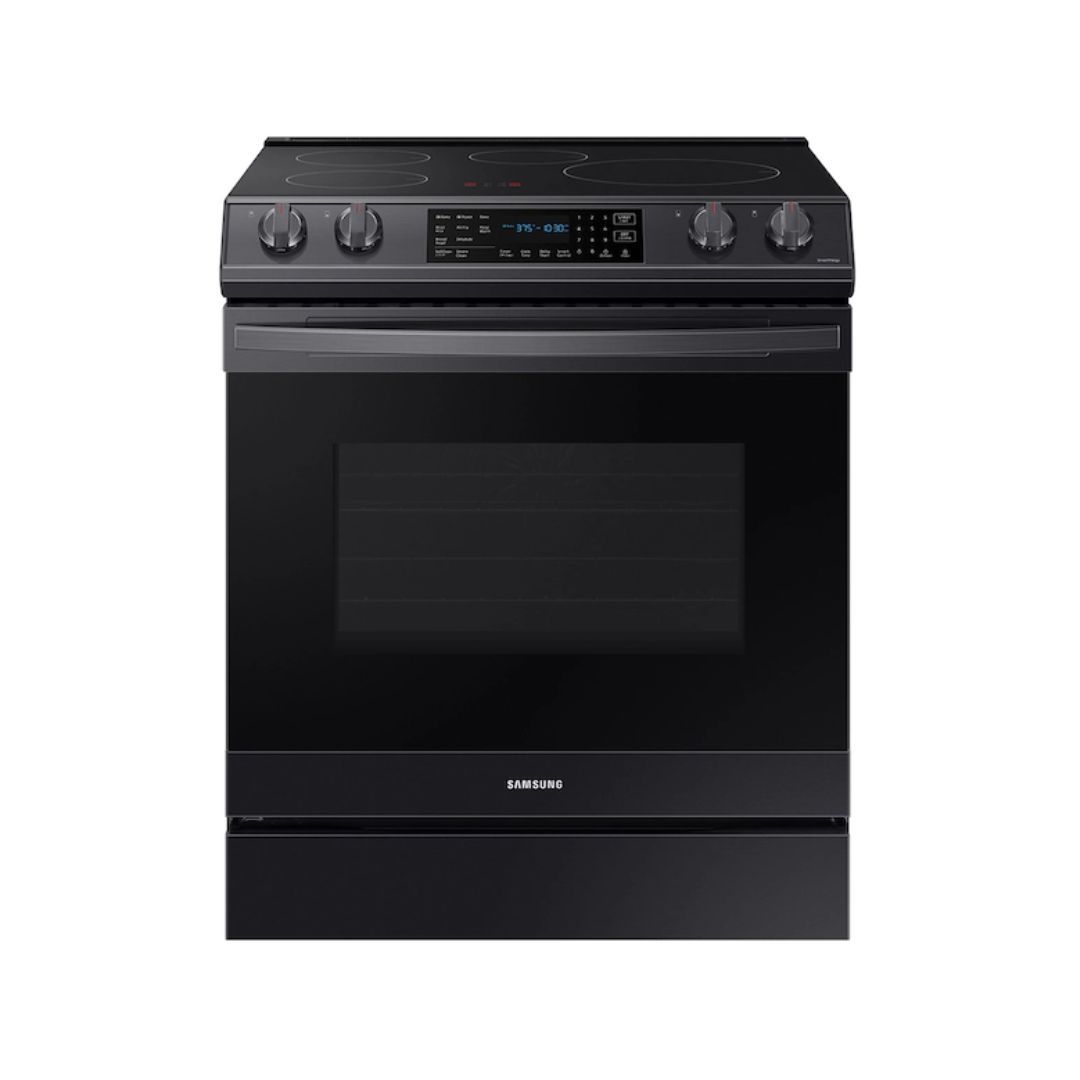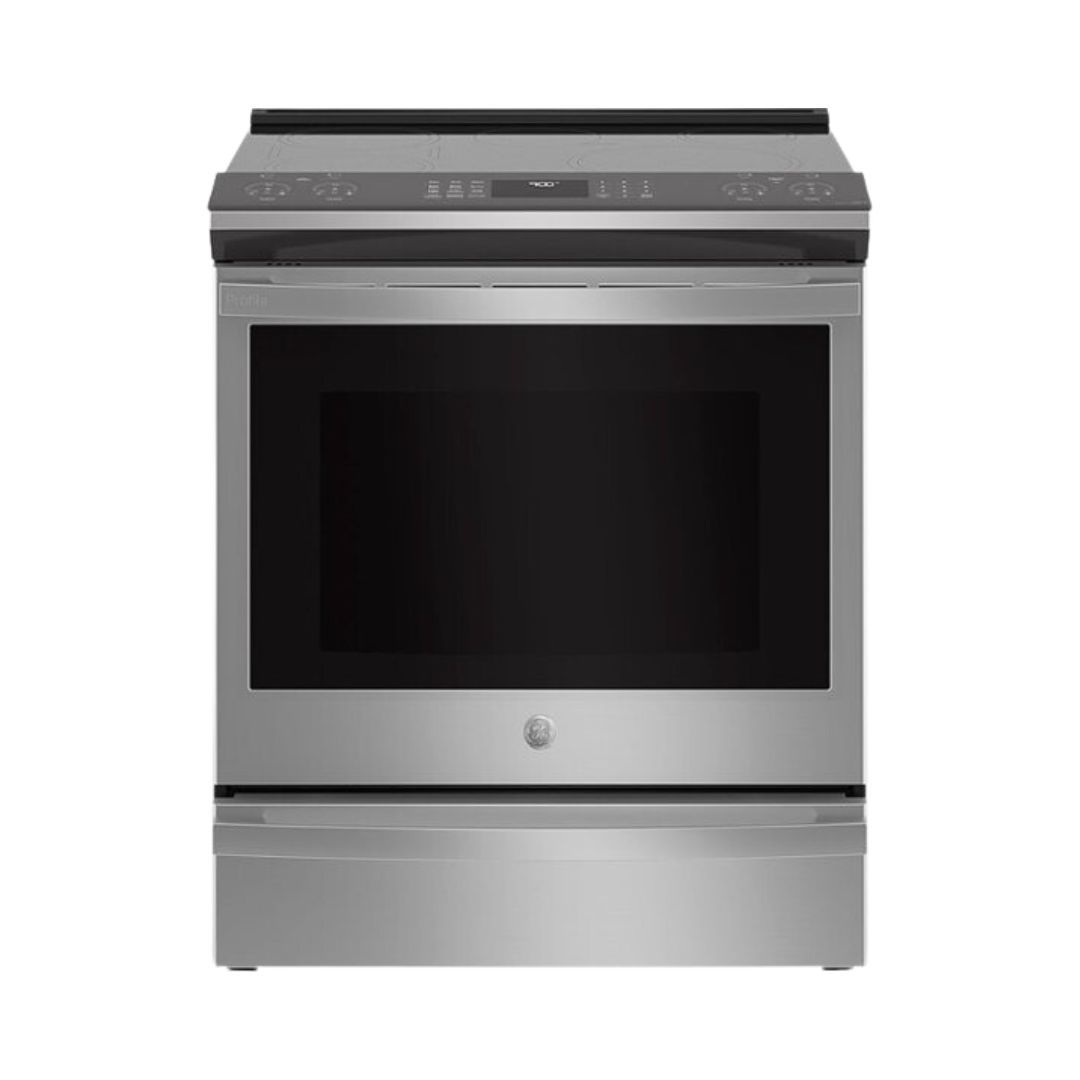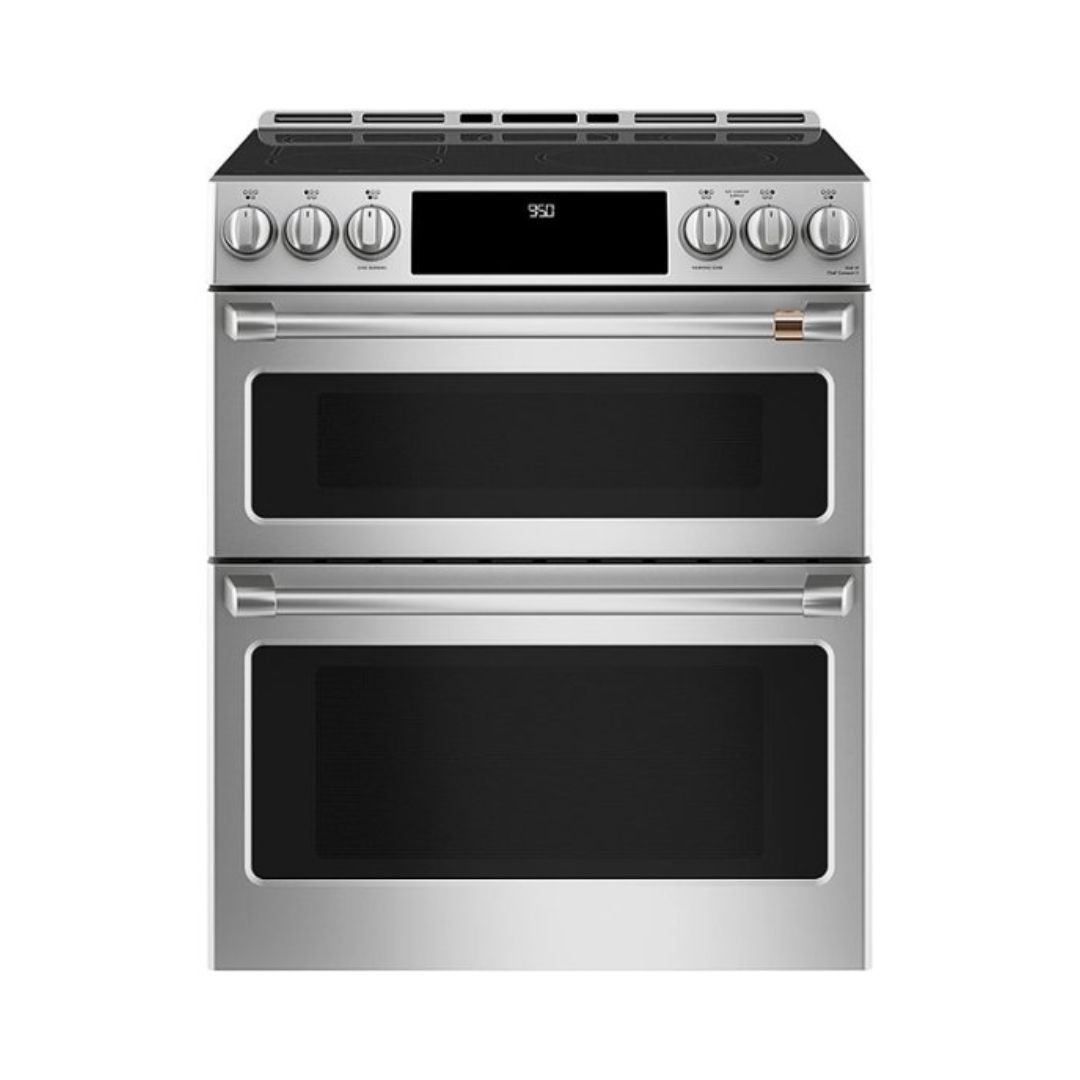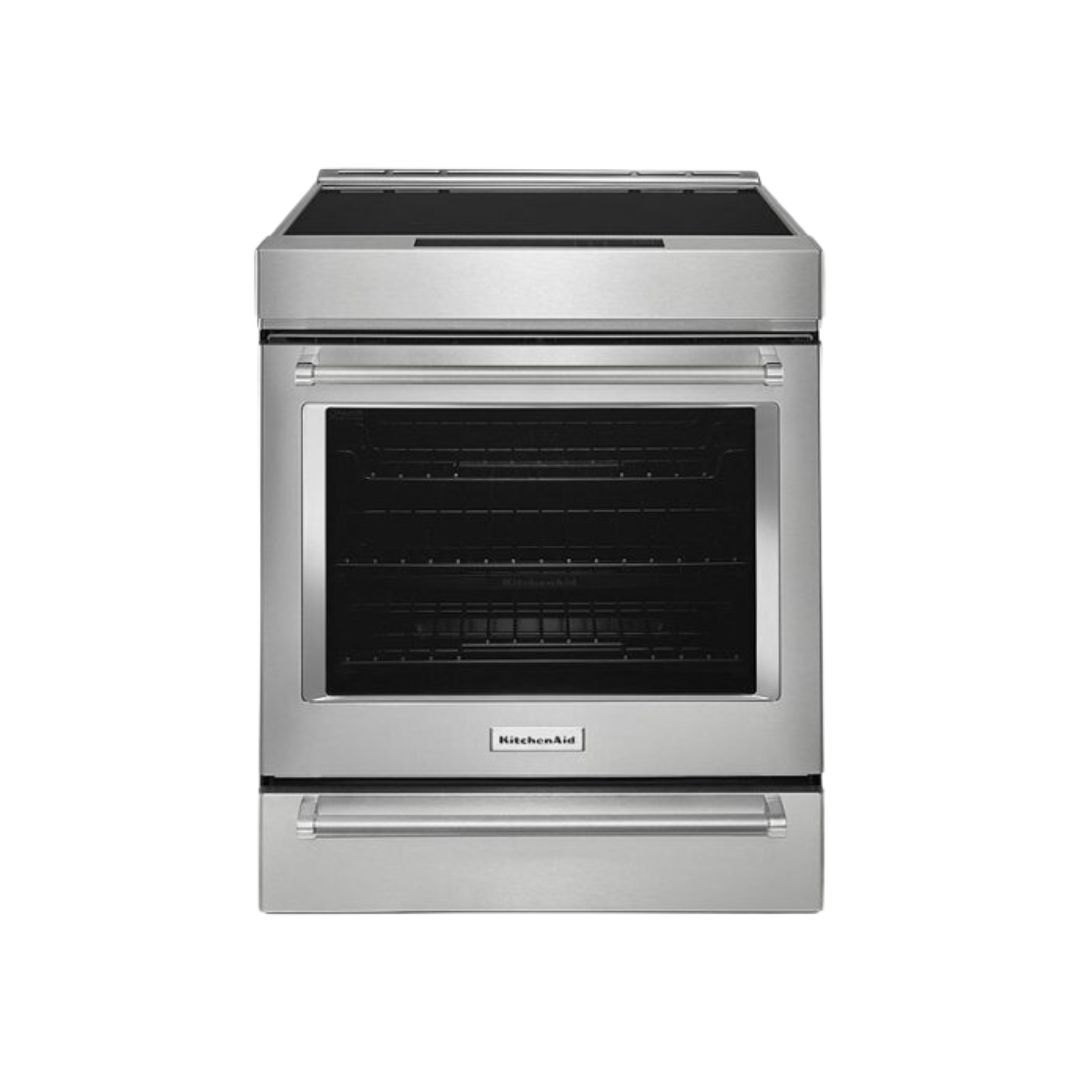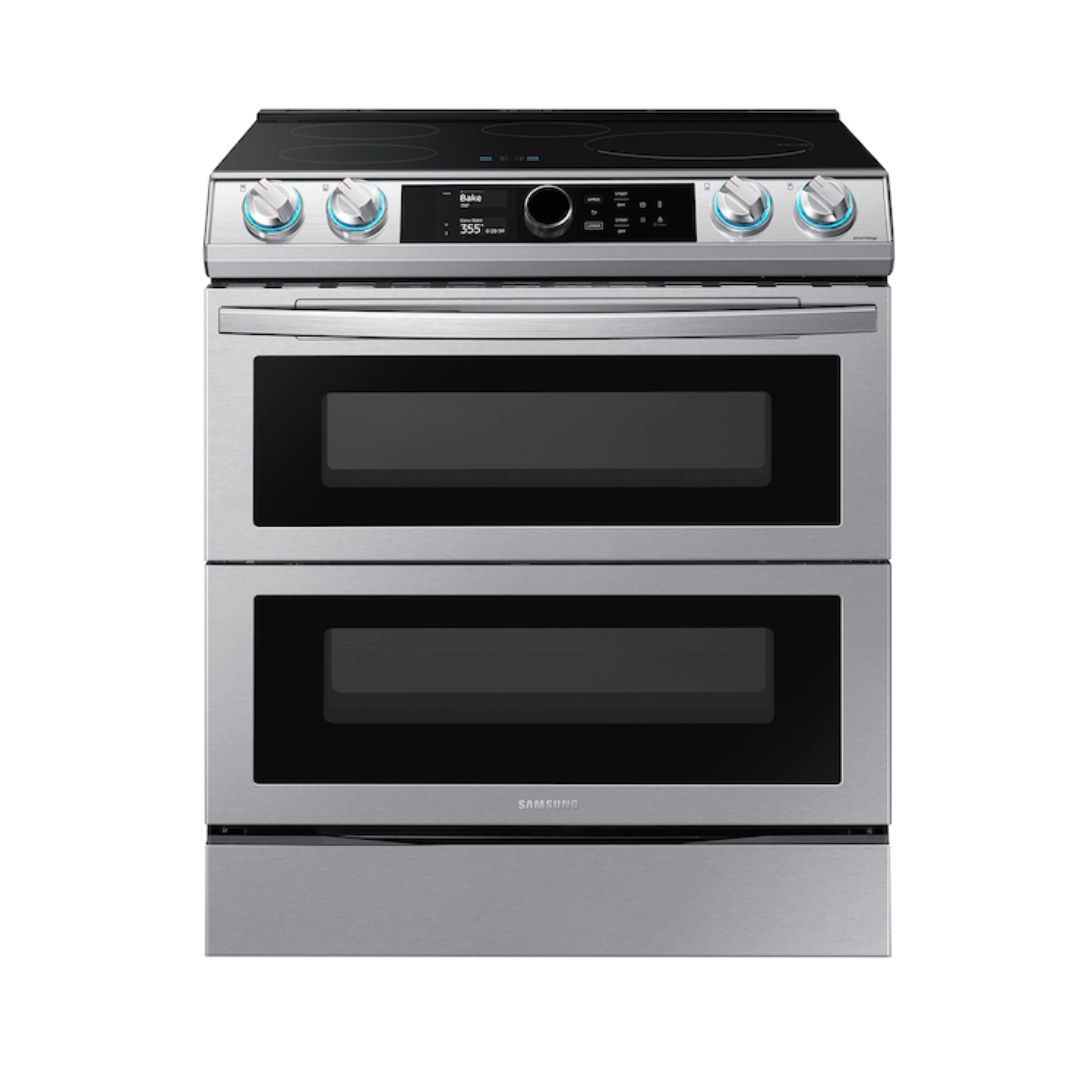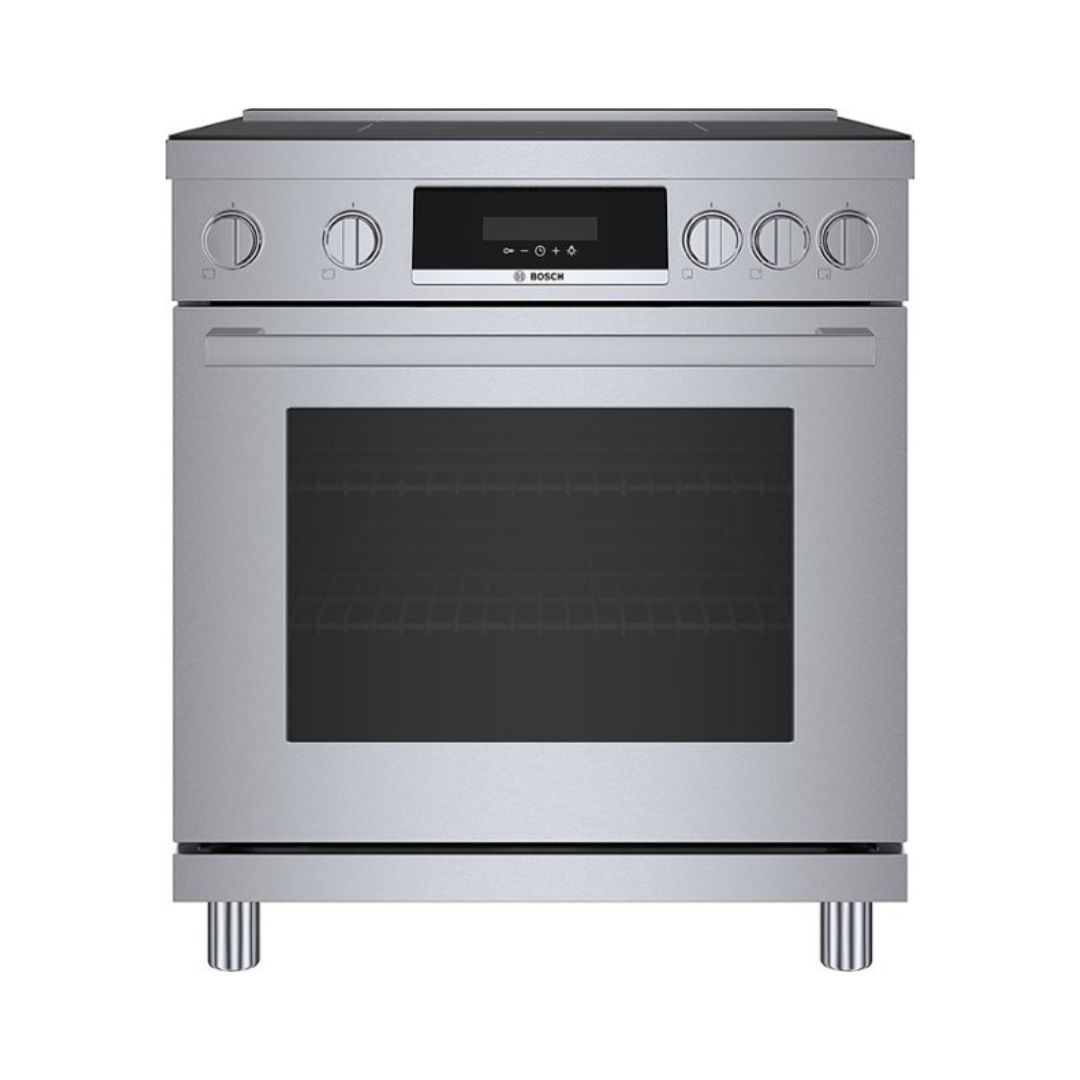We may be compensated if you purchase through links on our website. Our team is committed to delivering honest, objective, and independent reviews on home products and services.
If you like the idea of even, precise, and fast cooking, you may be thinking about upgrading to an induction range. Induction ranges use magnetic heat to cook directly from within your pots and pans, so the cooktop itself doesn’t get hot. This not only speeds up cooking but also makes cleanup easier since spilled food won’t get scorched onto the surface.
While induction ranges tend to cost more than gas or electric models—typically between $2,000 and $5,000—we’ve done the research to help you find the best options across different price points. Our top pick is the Samsung Rapid Heat Induction Slide-in Range, thanks to its versatile features and more affordable price. We’ve also rounded up five other great choices for a variety of budgets and needs.
Top 6 Induction Ranges
*Links below open to product retail page.
- Best Overall: Samsung Rapid Heat Induction Slide-in Range
- Best Sleek Design: GE Profile Slide-In Convection Range
- Best Luxury Range: Café Slide-In Double Oven Induction Convection Range
- Best for Fast Heating: KitchenAid Slide-In Electric Induction Range
- Best Features: Samsung Smart Slide-in Induction Range with Flex Duo
- Best Chef-Quality Range: Bosch Freestanding Industrial Style Range
Compare Top Induction Ranges
| Product | Oven Capacity | Number of Elements | Weight | Warranty (Parts and Labor) |
|---|---|---|---|---|
| LG Slide-In True Convection Range | 6.3 cu. ft. | 4 | 187.4 lbs | 1 year |
| Samsung Rapid Heat Induction Slide-in Range | 6.3 cu. ft. | 5 | 174 lbs | 1 year |
| GE Profile Slide-In Convection Range | 5.3 cu. ft. | 5 | 200 lbs | 1 year |
| Café Slide-In Double Oven Induction Convection Range | 6.7 cu. ft. | 5 | 236 lbs | 1 year |
| KitchenAid Slide-In Electric Induction Range | 6.4 cu. ft. | 4 | 211 lbs | 1 year |
| Samsung Smart Slide-in Induction Range with Flex Duo | 6.3 cu. ft. | 4 | 216 lbs | 1 year |
| Bosch Freestanding Industrial Style Range | 3.9 cu. ft. | 4 | 207 lbs | 1 year |
| Product | Oven Capacity | Number of Elements | Weight | Warranty (Parts and Labor) |
Terms To Know for Induction Ranges
- Elements: An “element” is a separate heating area on the stovetop. Some induction ovens offer different-sized elements for larger skillets and pots and smaller pans.
- Capacity: Measured in cubic feet, capacity refers to the internal space of the oven. A larger capacity means you can accommodate multiple racks or larger dishes.
How Induction Ranges Work
Induction technology produces heat by inducing a rapidly alternating magnetic field. An electric current races through copper coils, passing through a sheet of ceramic glass to generate electrical currents in an iron-containing, or ferromagnetic, pan.
The metal’s resistance instantly generates heat; the pot gets hot, but not the stovetop. Because heat can damage the internal components on any electric range, an induction stovetop also houses cooling fans. Here are our picks for the best induction ranges available.
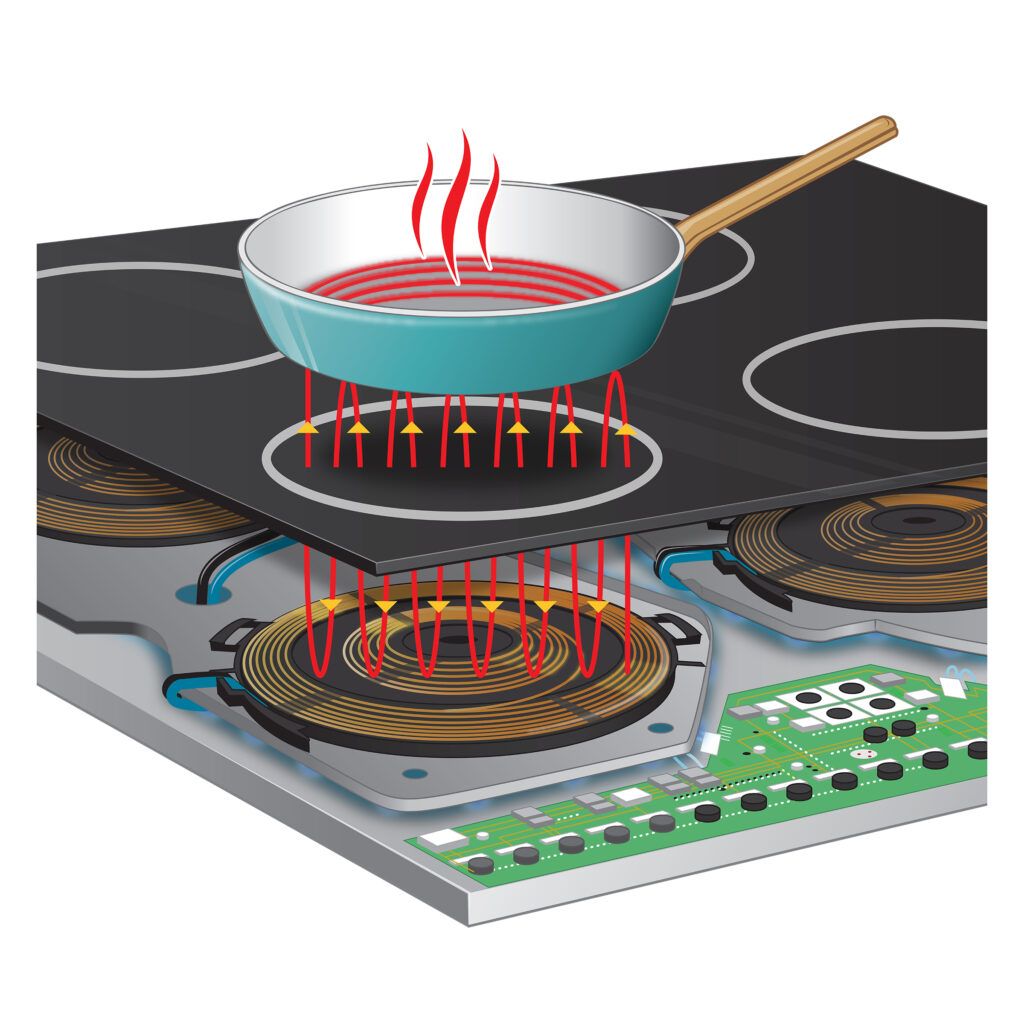
Best Overall
Good for: Someone looking for an upgrade for an old range at a reasonable price for the technology.
What Are People Saying About the Samsung Rapid Heat Induction Slide-in Range?
Fans of this range applaud it for its sleek appearance and quick boiling. The range also earns points for being easy to wipe down. Some people who own the range find the burner layout to be awkward, and others had concerns that the surface scratched too easily.
“We really love this unit! It outperforms what we previously had by a mile! Even the look of it is great!” — ChristopherO via Best Buy
“Range is beautiful; oven works like a dream and the induction surface heats quickly as promised … however as others have noted, this surface scratches like nothing I’ve seen before. We used it three times with an induction pan smooth as glass and it has five scratches. I am now using parchment paper on the surface and looking for induction heating pads. This is very disappointing as my sister has a seven year old range from a different brand without any scratches and they use cast iron pans!” — nmpwa via Samsung.com
Best Sleek Design
Good for: Someone designing a modern kitchen who loves to sync everything through apps.
What Are People Saying About the GE Profile Slide-In Convection Range?
This range scores points for its even, consistent heating and sleek, modern design. A few reviewers did find that this model has a steeper learning curve compared to ranges they had used in the past.
“It’s great. I’ll never own gas again. The stove tries a second to get used to, but it’s so much easier to cook on. Hearts up quicker and easier to keep consistent temps. The oven is great and super efficient.” — IanjM via Best Buy
“It does the job. I had a gas range and I think I prefer that. I felt I had more control. Still, the appliance works fine and as advertised.” — Medli via Best Buy
Best Luxury Range
Good for: The person who wants the stove to be the centerpiece of the kitchen.
What Are People Saying About the Café Slide-In Double Oven Induction Convection Range?
People who own this oven love that they can save energy by relying on the smaller stove for day-to-day cooking. They also love that both ovens can be used to cook different dishes at different temperatures when the occasion calls for it. Some reviewers disliked the disparate heating speeds between burners.
“I love my new range! The induction cooktop is great and so easy to keep clean. I cook a lot, so [I] bought the double ovens. They are smaller than the wall ovens I was used to, but sufficient for most of my cooking. Highly recommend this range.” — Momsnewoven via Best Buy
“Attractive unit, but several design flaws. First, the size of the burners on the range are hard to match with pots (required for induction). Second, the small, most commonly used burners are in the back. Finally, the air fryer function is nearly unusable. It would also make common sense that the small (top oven) should be the one that uses air fryer capability. Lighting is poor.” — ChrisD via Best Buy
Best for Fast Heating
Good for: Someone looking for hassle-free cooking.
What Are People Saying About the KitchenAid Slide-In Electric Induction Range?
People who own this range love the way that its even cooking allows their skills to shine in the kitchen. The biggest complaint is that a bulkier design with protruding handles can make this range stick out.
“It’s fast to heat and easy to clean. All the control of gas but faster responsiveness. Can’t recommend more highly!” — KathleenP via Best Buy
“I like that the oven bakes evenly, two lights in the oven, [and] stove gets hot immediately. I don’t like that it sticks out so much from the cabinets.” — Anonymous via Best Buy
Best Features
Good for: Someone who is transitioning from gas to induction cooking and wants all the features a modern chef is looking for.
What Are People Saying About the Samsung Smart Slide-in Induction Range with Flex Duo?
Overall, people are thrilled about the combination of an attractive design that also offers fast heating and dual ovens. A few reviewers share that the timer chimes on this oven are pretty grating, while others thought the split oven didn’t offer enough space.
“Well built and responsive induction cooktop. Love the flex duo oven and sliding oven rack plus extra storage door at the bottom. Beautiful modern addition to our kitchen!” — FrankieJ27 via Best Buy
“Pricey, but the induction cooktop is worth the hype. Flex duo leaves limited space, but it is convenient to have the option.” — BBGR8 via Best Buy
Best Chef-Quality Range: Bosch Freestanding Industrial Style Range
Good for: Serious chefs looking for elite cooking performance.
What Are People Saying About the Bosch Freestanding Industrial Style Range?
While a few people complained about the fan being noisy on this range, reviews and comments are overwhelmingly positive. The beautiful, streamlined look gets lots of praise. The impeccable and even cooking performance also wows customers.
“I am a professional chef and am very happy with the [straightforward] lack of wing-dings on this thing. Just a reliable oven and efficient induction cooktop. Some negative [reviews] I read before purchase mentioned a very loud oven fan and it almost kept me from buying this oven, but thank goodness I did anyway. The oven fan is as loud as a microwave fan or hood fan on medium-high (depending on the intensity of your fans). It is not disruptive. It does, however, do a great job at [maintaining] a [consistent] temperature. Highly [recommend]. Plus, it’s beautiful and I like that I can easily clean underneath it because there’s no bottom drawer.” — ABNtahoe via Bosch.com
“We bought the Bosch HIS8055U induction range because we love the ease and efficiency of induction top cooking. Also, we have other Bosch appliances that have performed well over a long lifetime. However, the oven on this range has a very very noisy cooling fan, 65 decibels over 20+ minutes. We had to close the dining room door to shut out the noise. If you have a group over for dinner, you would have to plan around the fan noise for a pleasant evening. One review suggested opening the oven door for faster cooling, shorter fan operation. If we had known how bad the fan noise was, we would have purchased a different range.” — alleycat via Bosch.com
What To Know Before Buying Induction Ranges
If you’re buying an induction range for the first time, the excitement of bringing such a beautiful, top-performing appliance into your home can quickly give way to confusion about how to select the right model. This guide covers what to know before you begin browsing.
What size induction range is best for my home?
A 30-inch induction range is the default choice for the standard kitchen. If you have space for a larger cooking surface, consider upgrading to a 36-inch model if that’s in your budget.
What are the different types of induction ranges?
Induction ranges are divided between standard induction and flexible induction. A standard induction range has an electric cooktop with two to four circular heating zones. A flexible induction range has fluid heating zones that are generally spread across the full cooktop. With a flexible range, you never have to worry about the size of your cookware because your cooking surface is not limited to small circles. However, flexible ranges generally cost much more than standard ranges.
What is the typical capacity of an induction range?
The average size of an oven with induction ranges in cubic feet is around 6.5 cubic feet. However, mainstream capacity is considered anywhere from 3 cubic feet to 7 cubic feet. Capacity is important to look at when purchasing a range with an oven because it lets you get an idea of how much you can cook at once.
How many heating elements do induction ranges have?
There is no standard rule for how many heating elements an induction range has to have. Some compact models have just one to two elements. However, the standard is four to five. Heating elements determine how many pots or pans you can have cooking at once.
What should I look for in the design of an induction range?
There are many features that can make or break an induction range. First, you’ll need to determine the aesthetic you need in your kitchen. Major appliance brands offer everything from industrial-style ranges to classic looks with decorative handles that go perfectly in aesthetic kitchens.
Handle design is important to consider if you have a tight kitchen. While some models have “barely there” handles, a few popular models have large, jutting handles that could become cumbersome as you’re moving around your kitchen. Don’t forget to look at a range’s legs! Most ranges simply slide in with very low clearance between the bottom of the range and the floor. However, a few models have tall legs that are close to being furniture-style legs.
How long do induction ranges last?
Generally, these workhorses last about 10 years with typical daily use. According to one trade analysis, power may start to sag after 2,500 hours of cooking time. Ceramic glass can scratch and will crack if hit with enough weight and force. Before you buy, read the fine print in the warranty, and ask if the manufacturer
sells replacement parts.
Induction Range Burner Features
Cooking surfaces on induction ranges have many similarities and a few differences. Here are some features to consider and compare.
- Cooking Zones: Most 30-inch induction ranges have four burners, typically sized for different pans and with one extra-large zone that can run from 8 to 11 inches. Some have a flex zone, or bridging option, which can heat an entire pan by straddling two cooking zones—helpful with griddles, oval pans, and gravy-inducing roasters.
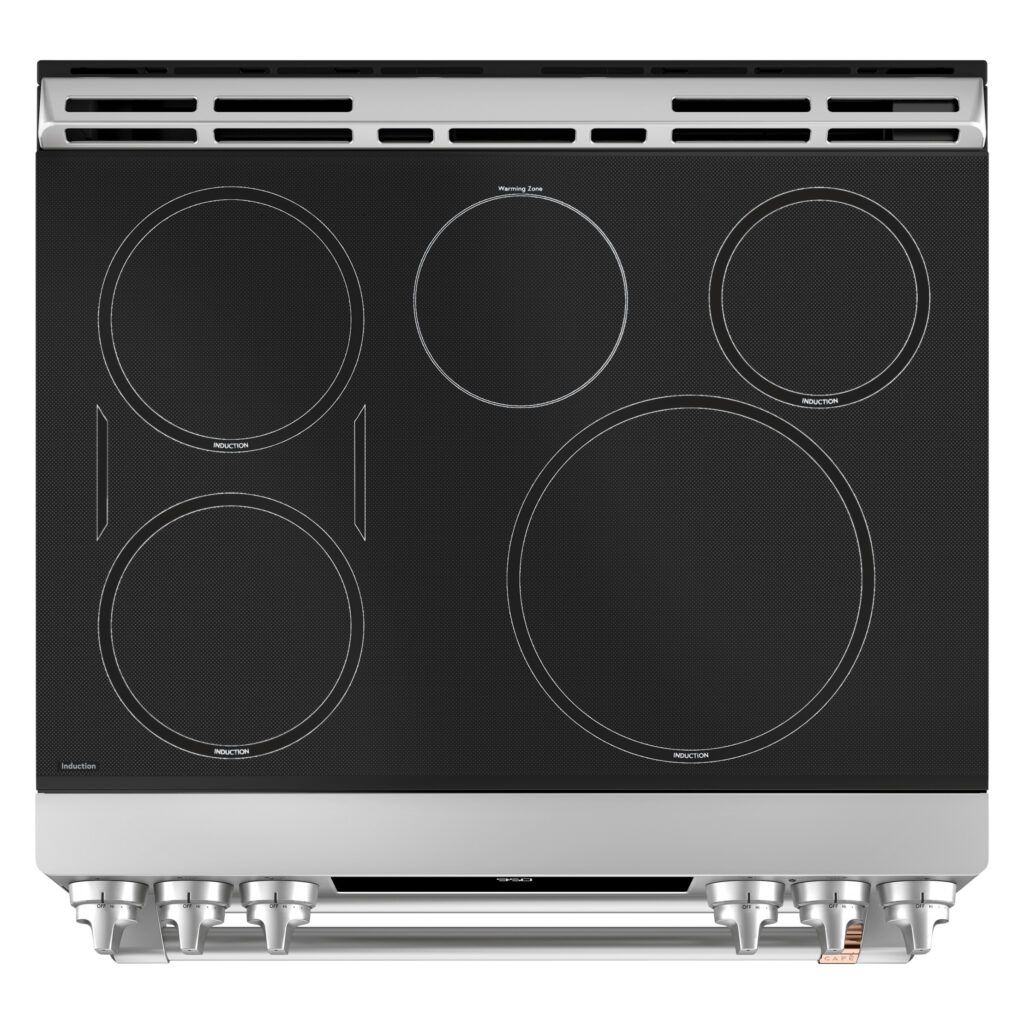
- Power Boost: Cooking zones typically draw from 1,200 to 3,700 watts each, assuming the pot matches the size of the cooking zone; if it’s smaller, it’s not drawing full power. Often one or more zones can increase their wattage (and speed) by using “power boost,” drawing power from another zone and reducing the watts available to it. This may suit your cooking style fine, but if you like to have lots of pots going at once, look for a range that allows you to either simmer on two burners while boosting power on a third, or to boost power on two burners at the same time, or to cook on all zones simultaneously.
- Controls: Watch for where they are—at the rear, on the glass stovetop, or in the front—how easy they are to manipulate (tap, press, slide, turn?), and how finely calibrated. Knobs can feel nice, but some ranges bristle with so many of them it’s hard to keep track of what they turn on.
- LED Indicators: Since cooking with induction comes with a learning curve, some manufacturers include
signposts that remind you where the power’s on. These include fake blue flames that grow bigger with higher heat settings (Samsung’s Smart Slide-In Induction Range With Virtual Flame) and glowing red bars that get longer with higher settings (LG’s Smart Wi-Fi-Enabled Induction Range). - Sous Vide Setting: This pro-style prep technique, which keeps ingredients at a set low temperature in a controlled hot-water bath, can be an option on some induction stovetops (and with some ovens, too).
Induction Range Oven Features
Some ovens share their capacity with a warming drawer or a second smaller oven. Here’s what to look for inside:
- True convection: European, or “true,” convection unites a fan (or fans) with a heating element on the oven’s rear wall to generate hot, fast winds for more even baking, roasting, and, in some cases, air frying. Some luxury models rely on a high-powered fan with separate heating elements.
- Air frying: The convection fans that come with some ranges blow enough hot air fast enough to make the oven into an air fryer, turning out bigger servings than you get with a countertop-hogging plug-in model.
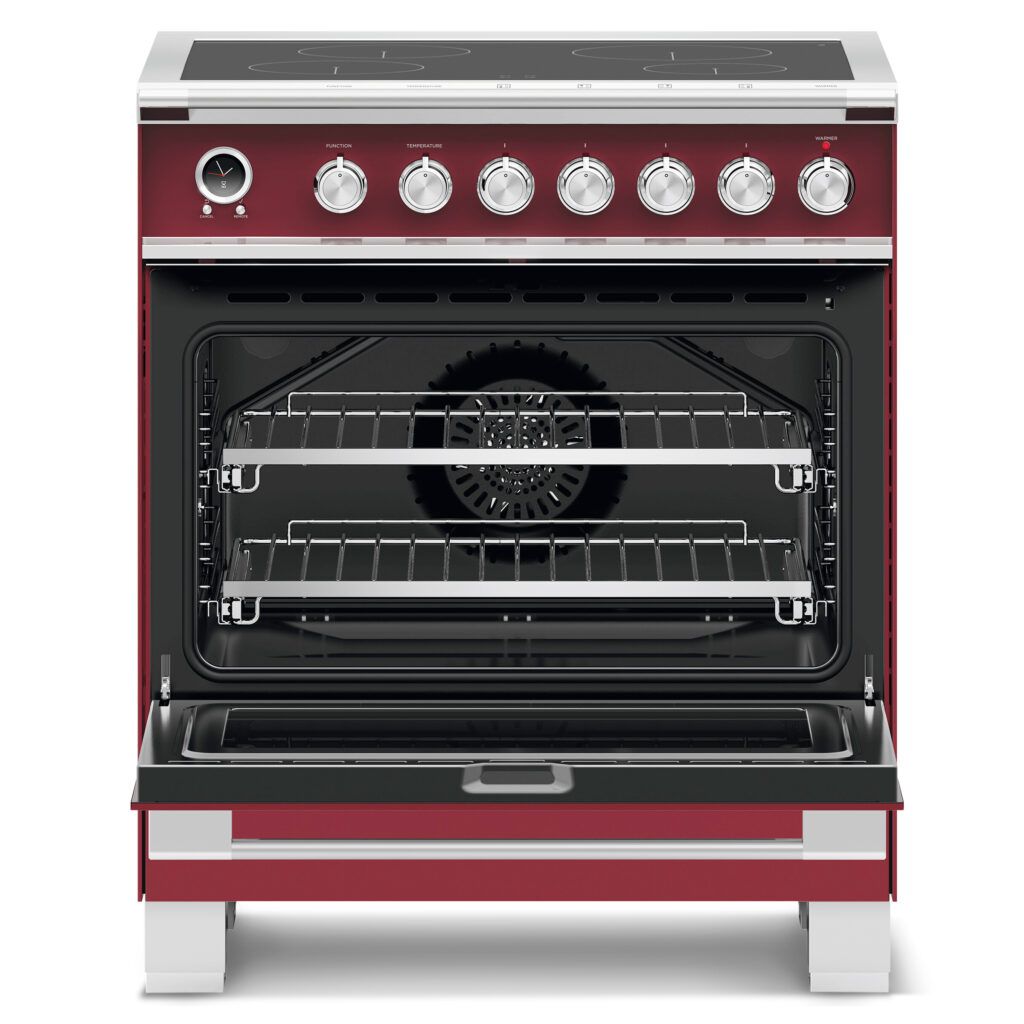
- Hidden baking element: This is a heater on the bottom of the oven that is sheathed in metal to make cleanup easier.
- Wider-ranging temperature settings: The ovens on some induction ranges can go as low as 80°F, for proofing dough, say, or as high as 550°F, for cooking pizza.
- Self-cleaning: This prolonged, super-high-heat setting is an option with most ovens. Some ranges have the option of a shorter, gentler steam-clean cycle.
Is an Induction Range Right for You?
Before buying an induction range, there are several plusses and minuses that you should take time to consider to make sure its right for your kitchen.
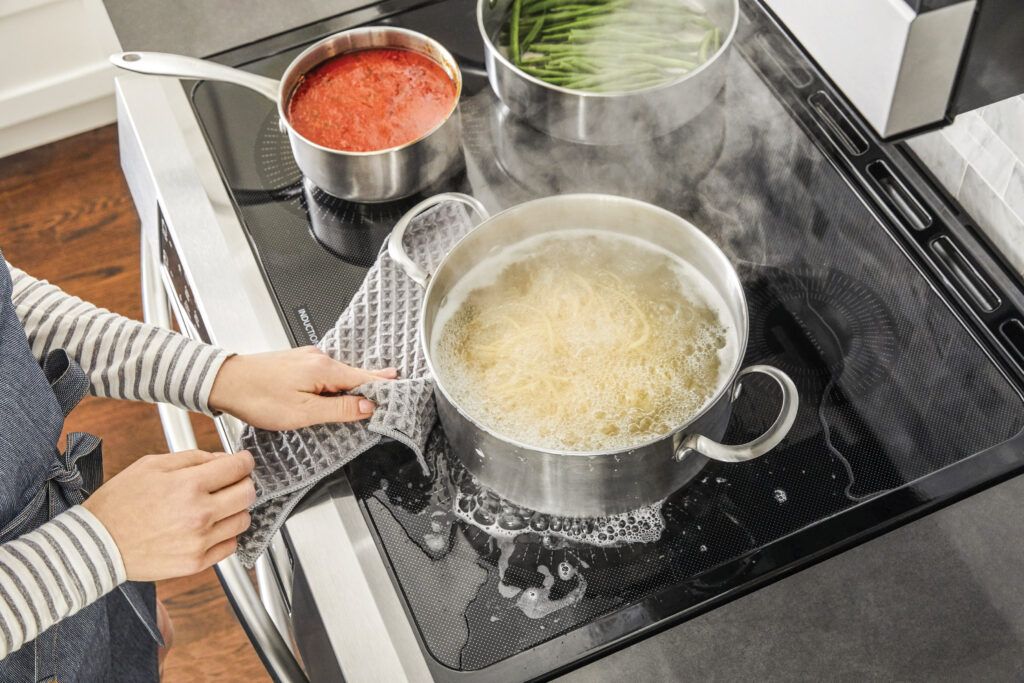
Pros
- Speed and efficiency. Gas is 32% efficient, meaning only about a third of the energy used goes into cooking. Standard electric ranges are 75% to 80% efficient. Induction is up to 90% efficient; that is why water boils so much faster. The pot becomes the burner. Less time warming up means less electricity used—and less need to crank the AC when the kitchen heats up.
- Responsiveness. On an induction range, food starts cooking the instant a current creates a magnetic field. And in virtually all cases, precision controls allow the food to be kept below a simmer.
- Safety. With standard electric ranges, it’s easy to get burned by residual heat long after a burner has been shut off. But with induction, only the pot gets hot; no pot, no heat—though it can make the glass warm to the touch. Most cooking zones have heat sensors: If a pan gets too hot, the stovetop shuts down. Many controls have child-proof locks, and induction ranges with front controls are often ADA-compliant.
- Eco-friendliness. Gas appliances produce lung irritants, including nitrogen dioxide (linked to asthma) and tiny particles called PM2.5. Gas ranges throw off climate-damaging methane by just sitting there, says the Natural Resources Defense Council, which equates the climate impact of gas cookers in the United States to tailpipe emissions from 500,000 cars.
Cons
- Power demands. You will need a dedicated 220- or 240-volt circuit and 40 to 50 amps. If you already have an electric range, you may have the panel capacity, but if switching from natural gas, you might need to upgrade. Electricians are in short supply right now, and upgrading a panel from 60 to 100 amps costs $800 to $1,500 on average—and from 100 amps to a new 200-amp panel, $1,300 to $3,000.
- Only works with certain pots and pans. Cast iron and enameled iron work well, and so does ferrite-containing stainless steel; the flatter the bottom of the pan is, the more efficient it will be. Ceramic, glass, copper, and aluminum pots and pans won’t cut it, though you can try them on top of an “induction interface disk” or a cast-iron skillet, but with a noticeable loss of power.
- Learning curve. If you’ve been cooking on a conventional electric cooktop, you may assume you can turn the heat on and walk away while the pot warms up. Not with induction, which acts fast. If you lift a pan off the cooking zone and move it to the counter to, say, check the steak for doneness, the power (and magnetic field) will likely cut off, so you will have to hit the controls again when you put the pan back down.
- Noise. Cooling fans are a necessity. At certain settings, all that magnetic activity can generate conspicuous clicks and buzzes.
Tips for Shopping for Induction Ranges
- Don’t wait until your old range breaks down to start the process—it takes time to comparison shop, and shipping delays are still common. Some ranges may be back-ordered and require a wait of six months or more.
- Look for local dealers that let you try before you buy. Some high-end showrooms and design centers
regularly host pro-chef demonstrations. - Check the latest consumer reviews, keeping in mind that not all reviews cover all brands,
especially at the high end. - Talk to friends, neighbors, and friends of friends; they will tell you if their induction range’s cooling fans are noisier than a leaf blower.
- Finally, remember that list prices tend to be higher than what you see online or at big-box stores, or what you can negotiate in a showroom. Appliance sales can bring down prices, too. Watch for holiday
specials–Memorial Day, July Fourth, Black Friday—which could include free installation and removal of your old range, if not a price cut. Or wait until January, when dealers may be eager to move out last year’s models.
Induction Range FAQs
What’s the difference between an electric range and an induction range?
Electric ranges rely on a centralized heat coil located under the cooktop to transfer energy to pots and pans on the surface of the burner. Using thermal conduction, heat goes from the coil to the cookware before reaching the food. With induction cooking, copper coils create a magnetic current that fully heats the cookware for faster heating while staying energy-efficient.
What is the difference between watts and BTUs?
While gas ranges talk in BTUs (British Thermal Units), with induction, it’s all about watts, and the two are hard to compare: Watt-Btu equivalency claims vary enormously. While the number of watts a burner can draw does indicate power, when comparing ranges, it makes more sense to ask how much time it takes to boil water: Frigidaire calculates that its induction range can boil a quart of tepid water in a 10-inch, 6-quart pot in half the time it takes a gas or electric stove.
What is the best cookware to use for an induction range?
The best options when cooking with induction heat are stainless steel, cast iron, carbon steel, and anodized aluminum. Materials that are not magnetic, like glass, copper, and aluminum, won’t work with induction ranges. However, you can purchase an adapter for your pan if it’s not compatible.
What is the typical maintenance for an induction range?
Unlike a conventional electric range, the induction stovetop does not get very hot, so spills don’t turn crusty fast and will clean up quickly with dish soap and water. Most ovens are self-cleaning. Some offer a steam-clean cycle: Water is poured on the bottom of the oven and then heated to loosen up sticky residue, which can then be wiped away with paper towels.
Do induction ranges require a range hood?
Yes, a range hood is still needed with an induction range because this appliance will still produce grease, oils, and smoke that need to be vented.
Our Methodology
This Old House has empowered homeowners and DIY-ers for more than four decades with top-notch home improvement advice in the form of television programs, print media, and digital content. Our team focuses on creating in-depth product and service review content. To date, we’ve published over 1,600 reviews on products in the home space, including power tools, outdoor equipment, major appliances, kitchen gadgets, electronics, and more that focus on product quality and helpfulness to our readers.
To provide our readers with the best recommendations possible, we rely on several key sources of information to help guide our selection process.
Initial Research: Our research process began by generating a list of induction ranges with a significant number of verified buyer reviews and an average customer review rating of 4–5 stars. We looked at positive and negative reviews alike, focusing on information from both satisfied and critical buyers.
Expert Insights: To complement our in-house expertise, our team looked at reviews and videos from trusted publications and independent testers, spoke with subject matter experts, and drew insights from reader contributions.
Final Product Selection: We then began fine-tuning our list by replacing older models with the latest versions and eliminating any discontinued models. From there, we compared each model’s feature set to create a final short list, selecting the best-in-class options for various buyers, budgets, and scenarios.
Once we conclude our research, we craft a comprehensive, user-friendly article of recommended products and additional information to help our readers make the right purchase.
Questions or Comments?
To share feedback or ask a question about this article, send a note to our team at reviews@thisoldhousereviews.com.
